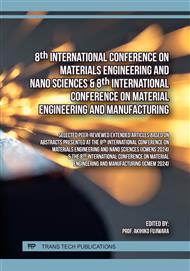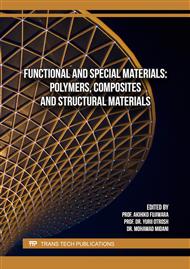p.3
p.11
p.17
p.23
p.31
p.37
p.43
p.49
Electrically Conductive Rubber by Modified Acetylene Black via Admicellar Polymerization
Abstract:
Nowadays, the enhancement of electrical conductivity in natural rubber has been widely studied by incorporating conductive particles with various techniques into rubber latex. Acetylene black is one of the carbon nanoparticles known for its electrical conductivity property. However, its hydrophobicity leads to poor dispersion in rubber latex. Therefore, admicellar polymerization (AP) technique was chosen to modify particle surface without changing the molecular structure. This technique alters surface hydrophobicity by means of coating ultrathin film of polymer onto the particles. Polypyrrole, a conductive polymer, was chosen to enhance the dispersion of acetylene black. The modified acetylene black was used as the electrically conductive additives in natural rubber. There were four variables in this study: i. the carbon particle-to-surfactant ratio, ii. the agitation speed during the AP step, iii. polymerization temperature, and iv. the surfactant agent-to-monomer ratio. The morphologies of modified particles were observed by SEM and TEM. The results showed that the best conditions yielding the lowest resistivity of conductive rubber at 1:3 for the carbon particle-to-surfactant mass ratio, at 1000 rpm for the agitator speed, in AP step was 4°C for the polymerization, and 1:5 for the mass ratio of the surfactant agent-to-monomer.
Info:
Periodical:
Pages:
11-16
Citation:
Online since:
September 2024
Authors:
Price:
Сopyright:
© 2024 Trans Tech Publications Ltd. All Rights Reserved
Share:
Citation:



